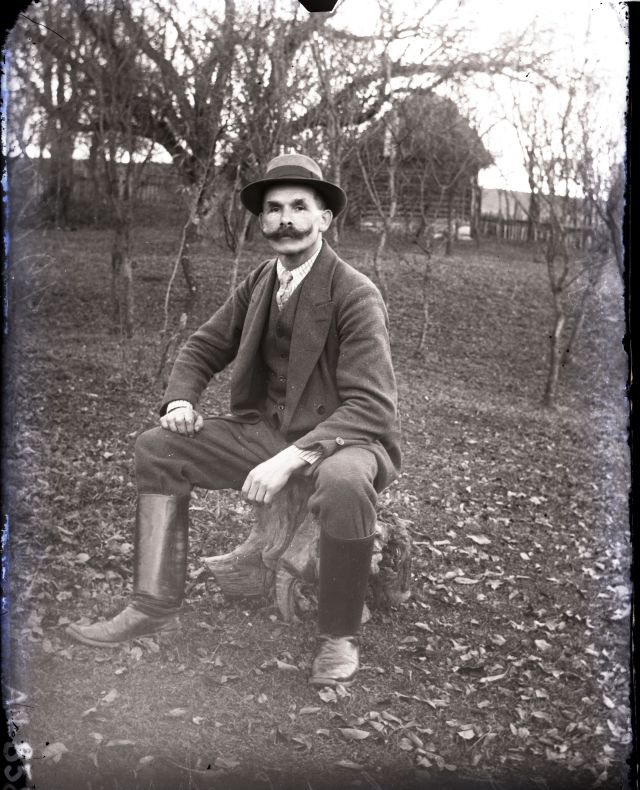Wojciech Migacz - peasant photographer of the Lachy Sądeckie countryside
In the archives of the District Museum in Nowy Sącz, a special collection consists of documentary and iconographic materials related to the peasant amateur photographer Wojciech Migacz (born September 7, 1874, died December 24, 1944) from the village of Gostwica near Nowy Sącz.
Wojciech Migacz was born into a wealthy peasant family of Józef and Maria née Szczygieł. In 1890, he graduated from a public elementary school in Gostwica. From 1890 to 1894, he attended the Imperial-Royal School of Wood Industry in Zakopane, where he obtained the specialty of a turner and woodcarver. Undoubtedly, he learned to photograph during his education in Zakopane. Over the next three years, i.e. from 1894 to 1897, he served in the 20th Galician Infantry Regiment of "Prussian Henry" in Kraków. After completing his military service, he worked for "masters of the wood industry in Kraków and Nowy Sącz". In 1902, he returned permanently to Gostwica, where his parents gave him a few acres of land.
Wojciech Migacz was born into a wealthy peasant family of Józef and Maria née Szczygieł. In 1890, he graduated from a public elementary school in Gostwica. From 1890 to 1894, he attended the Imperial-Royal School of Wood Industry in Zakopane, where he obtained the specialty of a turner and woodcarver. Undoubtedly, he learned to photograph during his education in Zakopane. Over the next three years, i.e. from 1894 to 1897, he served in the 20th Galician Infantry Regiment of "Prussian Henry" in Kraków. After completing his military service, he worked for "masters of the wood industry in Kraków and Nowy Sącz". In 1902, he returned permanently to Gostwica, where his parents gave him a few acres of land.
Wojciech Migacz - photographer
W. Migacz treated farming as well as turning and woodcarving as secondary occupations. Photography was not only a passion for him, but also a source of income. Running a business without a craftsman's license, which W. Migacz did not have, exposed the village photographer to numerous "criminal and administrative" problems on the part of the County Office in Nowy Sącz. Nevertheless, in the years of the Second Polish Republic, he photographed a lot. Most of the photos of W. Migacz in the Museum's possession date back to this period, mainly wedding and funeral photos, as well as individual portraits, mostly made to order. W. Migacz's home village, Gostwica, is located in an area inhabited by people known as Lachy Sądeckie. The collection of photographs and negatives by W. Migacz illustrates various aspects of Lach life: village buildings, a year-round cycle of agricultural activities and various farm works (e.g. plowing, sowing, harvesting, digging, building a peasant cottage, felling trees), social and family meetings (trip fire parties, weddings, baptisms, funerals), annual customs and rituals (e.g. Christmas, Palm Sunday) and cultural activities (e.g. Blinker "often theatrical and informative performances."
Reporter
Migacz's collection is dominated by commemorative family and collective photographs. They reflect family and country bonds. W. Migacz mainly photographed peasants, both poor and rich, slightly less often the rural intelligentsia. Only one of the museum photographs by W. Migacz shows Jews. In the late 1930s, W. Migacz sporadically began to abandon posed portrait photographs. However, at the beginning of the 1920s, he began to take photos of various events, which are of a reportage nature, e.g. W. Migacz in the photograph was a landscape. All the more valuable, due to iconographic values, are the pictures of Gostwica landscapes with peasant huts under thatched roofs and fields arranged in characteristic stripes. Noteworthy is also the panorama of Stary Sącz and its surroundings, consisting of six combined photos taken in 1915. W. Migacz constantly improved his photographic workshop, he was interested in all the news in this field. In the interwar period, he corresponded with the well-known photographic company of Kazimierz Greger from Poznań. In his home library, he had e.g. "Photography Handbook" published in Lviv in 1894, and "Practical Photography" by J. Świtkowski. He subscribed to "Photographic News" and "Polish Photographic Review". He studied photo information in other magazines. After the article entitled Photographs of lightning and thunderbolts” took several test photos of lightning in Gostwica.
The value of Wojciech Migacz's photographic work
The collection of photographs and negatives by W. Migacz is an excellent documentation of the culture of the Nowy Sącz village. Many elements of this culture - folk costume, residential or economic construction, farmer's and craftsman's work tools have irretrievably disappeared. W. Migacz's photographs, on the other hand, are a reliable document recording the bygone era, i.e. the first 40 years of the twentieth century of the Nowy Sącz village. In addition, W. Migacz's photographs reflect the civilization changes in the Nowy Sącz village, the evolution of folk costume, the influence of urban fashion, and the increase in contacts between the village and the city. Wojciech Migacz is the only photographer known so far who represents a unique peasant trend in Nowy Sącz photography. Thanks to his photographic legacy of high documentary value, both historical and iconographic, he stands out from other photographers of peasant origin in Poland. Currently, the Museum's collection includes an inventory of 787 photographs and 1,205 negatives by W. Migacz, which were acquired after World War II, mainly in the 1980s, from the photographer's niece, Zofia Bodziona, who lived in Gostwica.
Prepared by: Anna Bomba, Main Inventory of the Collections of the District Museum in Nowy Sącz
Prepared by: Anna Bomba, Main Inventory of the Collections of the District Museum in Nowy Sącz




